Dell XPS 15 L521X: A Detailed First Look
by Jarred Walton on July 25, 2012 1:10 AM ESTDell XPS 15 Gaming Performance (with ThrottleStop)
This is where things get a bit messy and confusing. The CPU throttling on BIOS version A01 through A04 is a severe enough problem that out-of-box gaming performance on the XPS 15 is substantially lower than expected. In most games that we tested, CPU throttling kicks in after anywhere from 30 to 90 seconds, at which point the CPU sits at 1.2GHz until you exit the game. This makes benchmark results highly variable, with the first run always being the fastest, and frankly it’s unacceptable. How this slipped through the cracks on a shipping laptop is something of a mystery, as it took all of five minutes with DiRT 3 and Batman: Arkham City for me to determine something was wrong with performance, and to then track down the root cause. OEMs take note: both games have built-in benchmarks and your performance labs should be using these and other high-profile games to check performance before you start shipping product. End of discussion.
Now, with that out of the way, we wanted to see what the XPS 15 could do with a bit of fine tuning on CPU clocks. Under the default settings on the A04 BIOS, CPU temperatures topped out at 80C, which is lower than we’ve seen on quite a few laptops. Furthermore, CPU clocks were almost always 2.8GHz (maximum Turbo Boost for four threads or more on the i7-3612QM) before throttling down to 1.2GHz, which seems rather myopic. The whole point of Intel’s Turbo Boost is to let the CPU run at the maximum sustainable clock speed without overheating, and right now that’s not happening.
A bit of tinkering with ThrottleStop 5.0 Beta 3 yielded CPU temperatures in the 80-90C range with a 23X multiplier, with some games capable of running at 2.5 or even 2.6GHz without overheating. Again, this isn’t something an end user should be required to use in our opinion, but thankfully it does allow substantially improved performance and it’s easy enough to enable/disable as needed. Depending on the game in question, we saw performance improve by anywhere from 10% to over 100% by using a 23X multiplier with the CPU PROC HOT signal disabled—Batman and DiRT 3 showed the greatest improvements. Note also that the difference at higher quality settings isn’t as large, as the GPU becomes more of a bottleneck. We have 1080p “Enthusiast” results for the XPS 15 as well as our 768p “Value” and 900p “Mainstream” scores, but in most games 1080p Enthusiast wasn’t playable so we won’t report those scores for now. Let’s start with our Value and Mainstream results, and then we’ll list “recommended” settings and frame rates for the XPS 15 running at 1080p.
Value Gaming Performance
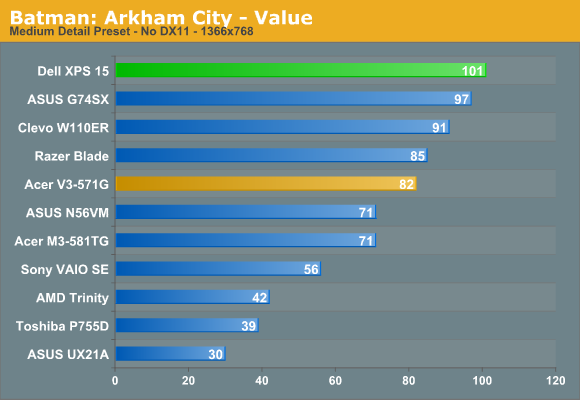

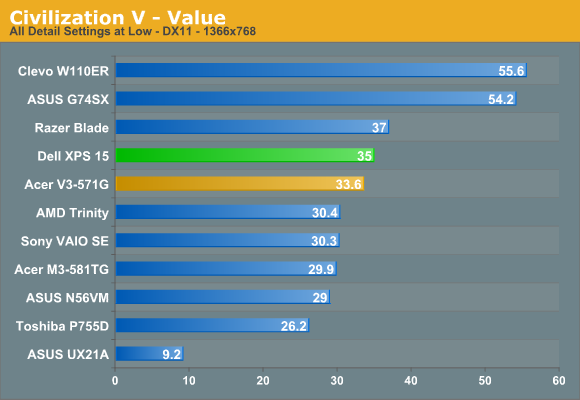

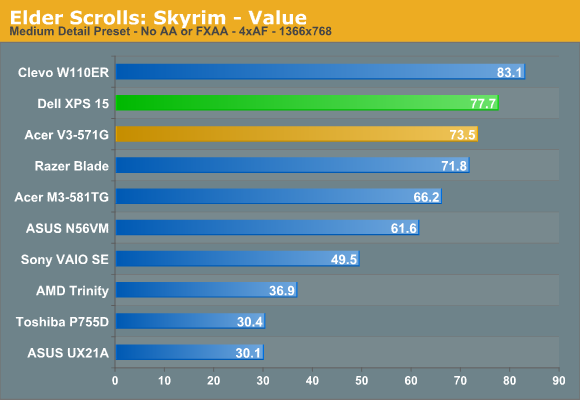
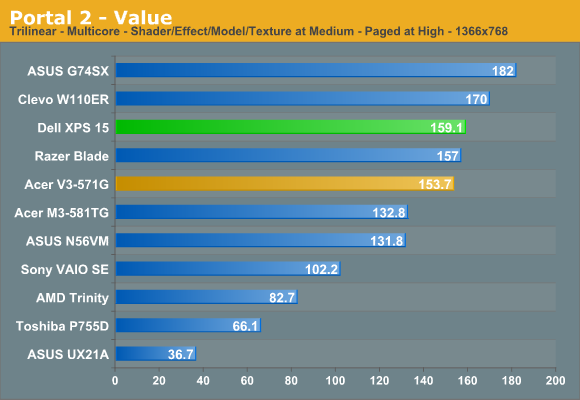
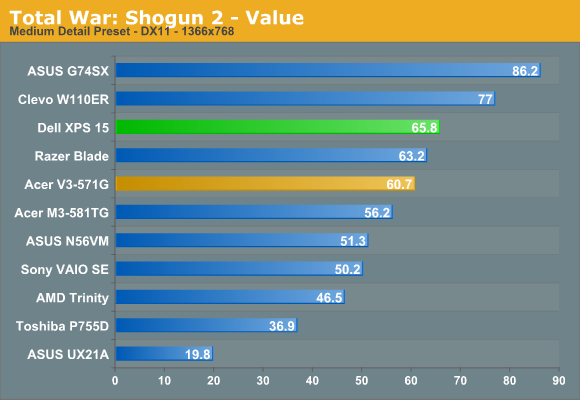
Our Value settings don’t pose any problem for the XPS 15, with all games easily besting 30FPS and most surpassing the 60FPS mark. The XPS 15 basically sweeps the table against the Acer V3, showing the value of using GDDR5 memory instead of DDR3 memory on the GPU. Also worth note is that Civilization V performance continues to be a bit quirky with certain driver versions; the original 296.01 drivers couldn’t even break 30FPS regardless of setting on the XPS 15, while the newer 304.79 beta drivers at least let you get 35FPS. One quick look at the W110ER results however shows that we ought to be able to get performance closer to 50FPS. I ran FRAPS while performing the Civ5 “lategameview” benchmark at one point to see what was going on, and for some reason performance appeared to fluctuate between 50FPS and 35FPS, where normally the frame rate is pretty steady. I’d guess a future NVIDIA driver will address the issue.
Mainstream Gaming Performance
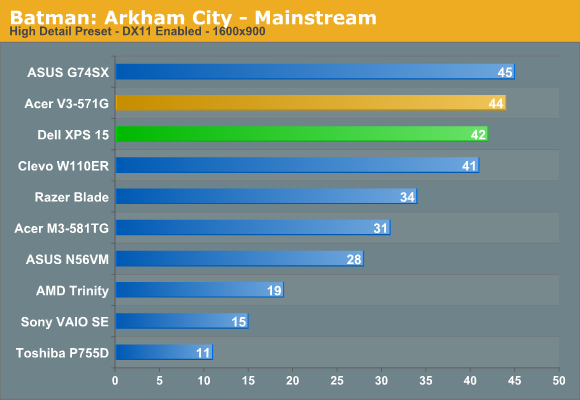
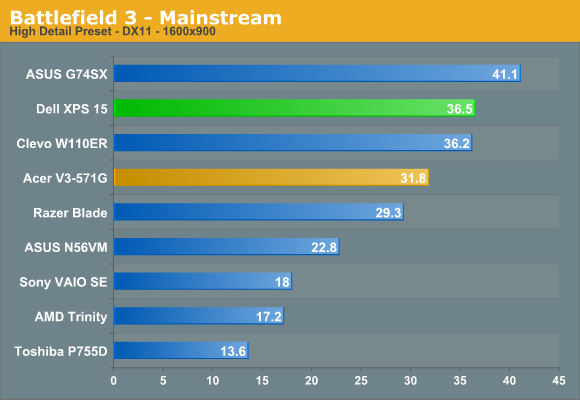
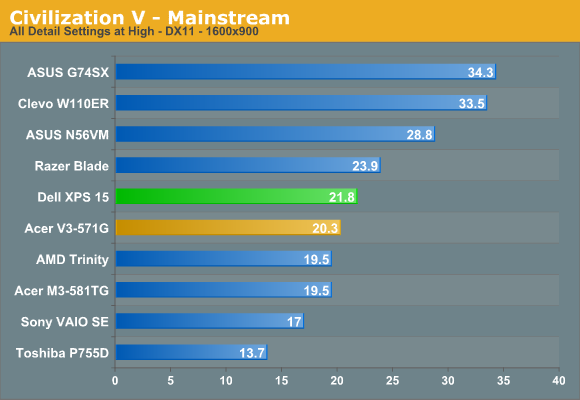
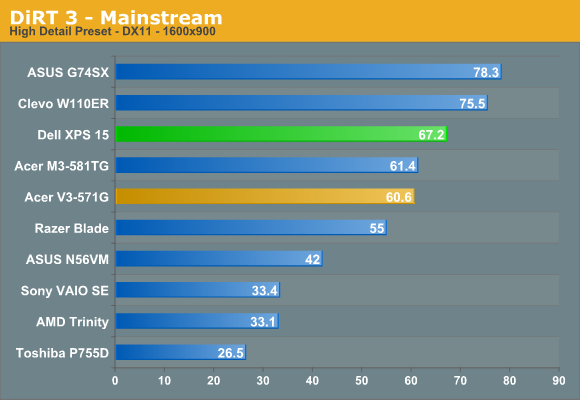
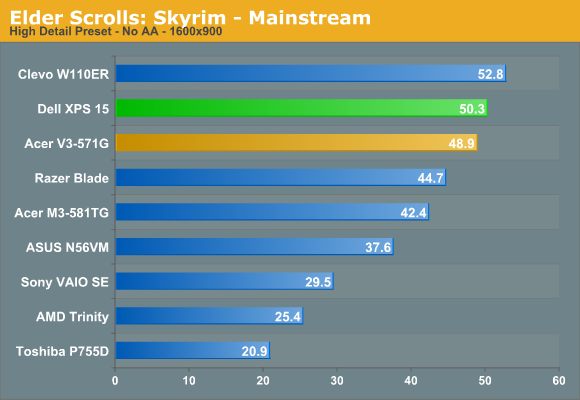
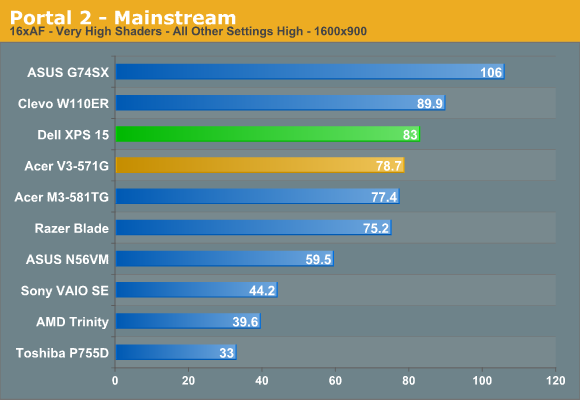

Mainstream performance generally follows the same pattern, only with lower frame rates. The GT 640M with GDDR5 is close to handling all of our test suite at 900p “High” details, with Battlefield 3 and Civilization V being the only two games where we’d recommend dropping to lower detail settings (and again, the drivers are likely a factor in Civ5 performance). It’s also interesting that the Acer V3 manages to eke out a win in Batman, indicating our lowered CPU clocks might be coming into play. Otherwise, the use of GDDR5 is typically able to improve GT 640M performance by an average of 8%, with up to 25% higher performance in at least one game (Batman using our Value settings).
|
Dell XPS 15 Gaming Recommended Settings for 1920x1080 |
|||
| Game | Detail | FPS | Notes |
| Batman: Arkham City |
Very High + 4xAA |
46 |
DX11 and PhysX both tend to be too much for the GT 640M, but you can max everything else out and maintain smooth frame rates. |
| Battlefield 3 |
Medium (“Value”) |
32.6 |
Single-player is okay at these settings, but multi-player will need to drop the resolution or use custom settings with some items on Low. |
| Civilization V | Low (“Value”) | 32.3 |
Civ5 needs a better driver, and we’ve seen higher scores in the past. Until then, setting everything to “Low” is your best bet for 1080p. |
| DiRT 3 | High + 4xAA | 45.8 |
Very fluid at the High defaults with 4xAA. If you try Ultra without AA, you’ll be closer to 30FPS. |
| Portal 2 | Max + 4xAA | 57.8 |
You can pretty much max out the settings in Portal 2 and still maintain fluid frame rates. |
| Skyrim | Ultra + 4xAA | 30.8 |
Skyrim is playable at 30FPS, and so our Enthusiast defaults work well enough. If you want slightly higher performance, you can use FXAA instead of 4xAA and get 35 FPS. |
| Total War: Shogun 2 |
High (“Mainstream”) |
34.8 |
The “High” preset seems to work best, though “Very High” with AA disabled is also viable. |
Most of the games’ settings are straightforward, but a couple warrant further explanation. In Batman, enabling Very High with PhysX is borderline playable, with an average frame rate of 27 FPS; DX11 without 4xAA is a similar 26 FPS, and enabling 4xAA in either mode drops a few FPS whereas FXAA is basically free. Civ5 performance is still a bit chaotic (see below), so take those scores with a grain of salt for now. Finally, our test scene in Skyrim happens to be one of the lowest performing areas we could find, so while we report 30 FPS there are many areas in the game that will run in excess of 60 FPS.
As mentioned earlier, Civilization V and Total War: Shogun 2 ran better with the most recent 304.79 beta drivers, and that’s what we used for the above settings. The remaining games all ran best with the official 296.01 Dell drivers, though at some point we expect to see a new WHQL driver that will provide the best of both worlds (and hopefully further improve Civ5 performance). Not shown in our charts is another popular game, Diablo III; given that the Acer V3 could handle maxed out settings, the same holds for the XPS 15. With GDDR5 memory, the GT 640M ends up being around 10% faster on average compared to DDR3; it can certainly handle gaming at 1080p, but in many games you’ll need to lower the detail settings somewhat to be fully playable.










109 Comments
View All Comments
JarredWalton - Wednesday, July 25, 2012 - link
I'll look into this when working on the "final" review -- e.g. when the next A05 BIOS is officially released. For gaming in general, I don't think it will matter too much, as most don't tax all four cores. Still, stranger things have happened.yyrkoon - Wednesday, July 25, 2012 - link
Well the reason why I say this Jarred. Is because of how I understand these CPU's throttle. If they do operate the way understand it. These should be able to clock higher with only two cores being used fully. Then a lot of games only really need 1-2 cores. But not all.I myself have tried this on a game that I know is CPU dependent. It did not increase performance for the game, but it does help with heat. Well, performance wise, it did help because I was able to overclock the processor. Then remain inside the same heat envelope.
However, my system is based on an AMD A6-3400.
JarredWalton - Thursday, July 26, 2012 - link
So I did a quick test just now. Setting Batman: AC affinity to cores 0-3 (or cores 0 and 2) resulted in throttling within the first 60 seconds or so of running the Batman benchmark. So I turned to ThrottleStop again and decided to go for broke and set the multiplier for "Turbo" (maximum) and disabled CPU PROC HOT. I reached a temperatures of 100C on the first two cores after running the benchmark three times, and while the laptop didn't crash I wouldn't be comfortable running those temps.Next, I dropped the ThrottleStop multiplier to 26X and retested. Cores one and two still hit 98C after a few loops, and performance wasn't any better or worse (89-90 FPS for our "Value" 768p Medium settings). Then I tried ThrottleStop with the multiplier set to 23X but without any affinity setting. Performance went up slightly (91-92 FPS), and all four CPU cores topped out at around 91C, so overall performance was slightly up and temps were slightly down by just restricting the multiplier more rather than using CPU affinity.
Obviously, results for affinity will vary depending on game. Some games will benefit from additional cores (albeit slightly) and others really don't use more than two. If you're really hoping to control temperatures, though, setting a 23X multiplier as well as affinity should be a bit better than just TS alone.
yyrkoon - Friday, July 27, 2012 - link
Jarred, thanks for taking the time to look into it.It is a shame that what I was thinking did not pan out. It was a shot in the dark to begin with. Based on personal experiences of my own. So I think what that confirms in my mind anyhow is that Dell needs to work on a much better cooling design for this series of laptops. Maybe just putting in a higher RPM fan will work too. Like I think you had suggested.
Personally, I would not care if the case design were a bit thicker to allow for better cooling. Nor would I care if the laptop were a bit heavier too. But as I stated in another post, I am most likely not the norm in my laptop usage.
alfling - Wednesday, July 25, 2012 - link
1) Please don't start here another "Apple fanboys vs Apple haters" battle like in most other reviews :)2) To the reviewer: many people experienced significant drops in download speed (upload keeps constant) when being out of line of sight from the router, while with other laptops (also older ones) keeps being good. Could you please try to walk away from the router and check for us?
3) To the reviewer (again): I heard some people complaining that in white or very light screens (like Google homepage) they can clearly see the pixel grid of the display, but nothing official has come from Dell yet. Could you please tell us if you experience the same issue?
Thank you in advance!
JarredWalton - Wednesday, July 25, 2012 - link
WiFi connection speed over longer distances is a bit of a craps shoot, but I did read somewhere that Dell is working on tuning the WiFi performance as well. There are so many variables at play (just the type of router and the testing environment introduce all sorts of factors) that without doing a massive amount of work I couldn't say if the XPS 15 wireless is underperforming or not. I'll try to look into this a bit more for the final (next BIOS) review.Regarding the LCD, I don't see the grid when looking at static content, but as I noted in the review, moving windows around really shows some "fuzziness" on high contrast edges. I see similar behavior on most TN panels, and it's caused by the 6-bit to 8-bit dithering/interpolation AFAIK. Trying to capture this in a picture or video would unfortunately require a better camera/lens than I have. Anyway, the LCD is better than a lot of displays, but the ASUS N56VM/VZ 1080p panel is better IMO, and so is the old XPS L501x LCD (which had better colors and gamut as well). Will most people notice? Nope, but enthusiasts and screen connoisseurs might. The "dithering effect" doesn't bother me, but the bluish cast of the LCD is definitely noticeable.
alfling - Wednesday, July 25, 2012 - link
Thank you very much for your prompt replyrnmisrahi - Wednesday, November 14, 2012 - link
Indeed, there are many problems with the wireless card. Unless you're very near your router, the speed slows down to 2 mbps, while other older machines give me 30 mbps downstream, of course.Look at this Youtube: http://www.youtube.com/all_comments?v=x-KFW7_UxJM
dragosmp - Wednesday, July 25, 2012 - link
So what's the point of a quad core Core i7 and a discrete GPU if the chassis can't cool them? So you do have 4 cores than can potentially go to 2.8GHz, but if you try to actually use them they'll get throttled to 1.2GHz; or at 1.8GHz if this is as much as the chassis can take, and by the way thanks Jarred for doing this bit of investigative journalism. Unless they accelerate the fan further and/or modify the cooling/chassis, with all the BIOS engineers in the world they won't be able to pull more than ~1.8GHz.At this point I'm wondering, isn't the i7 a check box feature? From an engineering standpoint if the overall dissipation power of the chassis is xW you can take advantage of the thermal capacity and go over the xW for a certain period of time without passing the temperature threshold. Dell took this further: put a slim chassis with probably half the thermal capacitance of the old XPS 15, made it slimmer thus reduced the dissipation power and kept the same TDP CPU (which is itself surpassed while Turbo-ing). I wonder what if a 25W DC Core i5 would be faster than the 35W i7 in most apps, even heavy threaded apps, simply due to it keeping higher clocks per core.
As a engineer I see no point in this, but if I were a seller I sure wouldn't want to be the only one that doesn't support the fastest CPU as pointless as that may be.
JarredWalton - Wednesday, July 25, 2012 - link
I think the issue isn't the quad-core CPU so much as the total amount of power the cooling system needs to dissipate. If the GT 640M GDDR5 can use 40-45W of power (which seems about right) and the CPU uses up to 35W, then the cooling needs to be able to handle at least 75-80W of heat in order to avoid problems. Given what we're seeing with throttling, it looks like the cooling is probably only able to handle 60-65W, so something has to give.As far as the quad-core being useless, keep in mind that I never saw any throttling when running just CPU-intensive workloads. It's only the combination of CPU and GPU both being loaded where we run into issues. Games do that, and professional CAD/CAM type programs would do it as well, but a lot of other tasks aren't really going to be a problem I don't think. Even video editing probably doesn't put enough of a strain on the GPU to trigger throttling -- though I'll have to look into that later.